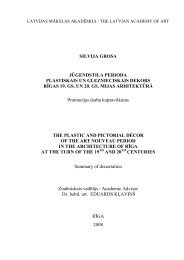Institute of Art History of the Latvian Academy of Art Anna Ancāne ...
Institute of Art History of the Latvian Academy of Art Anna Ancāne ...
Institute of Art History of the Latvian Academy of Art Anna Ancāne ...
You also want an ePaper? Increase the reach of your titles
YUMPU automatically turns print PDFs into web optimized ePapers that Google loves.
INTRODUCTION<br />
1. Topicality <strong>of</strong> <strong>the</strong> subject<br />
17 th century is an important period in Latvia’s history <strong>of</strong> architecture,<br />
marking dynamic changes in both urban planning and architecture. This<br />
historical period typified by artistic phenomena on <strong>the</strong> verge <strong>of</strong> two<br />
epochs still provides little examined <strong>the</strong>mes and unanswered questions.<br />
The topicality <strong>of</strong> <strong>the</strong> subject and <strong>the</strong> main tasks <strong>of</strong> <strong>the</strong> doctoral <strong>the</strong>sis are<br />
conditioned by <strong>the</strong> need for a deeper analysis, revealing Riga’s urban<br />
planning and tendencies <strong>of</strong> architectural development in a unified context.<br />
Analysis <strong>of</strong> materials allowed formulating answers to <strong>the</strong> questions<br />
dealing with <strong>the</strong> processes and changes in urban planning, development<br />
<strong>of</strong> street network, and typology <strong>of</strong> dwelling houses as well as <strong>the</strong><br />
architectural finish <strong>of</strong> buildings.<br />
2. The aim and tasks <strong>of</strong> <strong>the</strong> work<br />
The aim <strong>of</strong> <strong>the</strong> work was to create a versatile historical interpretation <strong>of</strong><br />
Riga’s architectural scene in <strong>the</strong> 2 nd half <strong>of</strong> <strong>the</strong> 17 th century, based on<br />
detailed research <strong>of</strong> all available materials;<br />
Tasks <strong>of</strong> <strong>the</strong> work:<br />
1) to characterise innovations in Riga’s urban planning <strong>of</strong> <strong>the</strong> 2 nd half <strong>of</strong><br />
<strong>the</strong> 17 th century, to elucidate <strong>the</strong> developmental logic <strong>of</strong> street network<br />
and view each particular object in relation to o<strong>the</strong>r objects;<br />
2) to define <strong>the</strong> typology <strong>of</strong> dwelling houses and interpret some most<br />
important buildings. To clarify what kind <strong>of</strong> buildings formed <strong>the</strong><br />
background for some most outstanding artefacts;<br />
3) to describe <strong>the</strong> architectural finish and décor <strong>of</strong> dwelling houses;<br />
4) to determine <strong>the</strong> specificity <strong>of</strong> Riga’s Baroque architecture in <strong>the</strong><br />
context <strong>of</strong> Eastern Baltic and o<strong>the</strong>r countries, tracing <strong>the</strong> possible stylistic<br />
tendencies and leading trends.<br />
3. Methods <strong>of</strong> research<br />
Pluralist or complex method has been used in <strong>the</strong> promotion work.<br />
Empirical study <strong>of</strong> materials was followed by <strong>the</strong>ir interpretation, using<br />
<strong>the</strong> method <strong>of</strong> historical and stylistic research, including formal analysis,<br />
typological method, iconography <strong>of</strong> particular decorative motifs and<br />
subsequent semantics. Indication <strong>of</strong> <strong>the</strong> commissioner, <strong>the</strong> meaning <strong>of</strong><br />
political power and social conditions involved also some aspects <strong>of</strong> <strong>the</strong><br />
sociological method.<br />
4. The research object and materials<br />
The object <strong>of</strong> research is <strong>the</strong> development <strong>of</strong> <strong>the</strong> layout, buildings and<br />
visual image <strong>of</strong> <strong>the</strong> town in <strong>the</strong> 2 nd half <strong>of</strong> <strong>the</strong> 17 th century, so objects in<br />
situ have been studied as far as possible. The number <strong>of</strong> Riga’s buildings<br />
dated by <strong>the</strong> 2 nd half <strong>of</strong> <strong>the</strong> 17 th century is quite large, so both <strong>the</strong> most<br />
significant monuments (Reutern’s House, Dannenstern’s House, St.<br />
Peter’s Church tower and west-side façade) and typological groups <strong>of</strong><br />
3












